PSYC105 Report: Road Safety Analysis - Cell Phones & Driving 2018
VerifiedAdded on 2023/06/05
|11
|4556
|457
Report
AI Summary
This PSYC105 report investigates the impact of cell phone use, specifically talking and texting while driving, on road safety in Western Australia. The study utilizes a survey administered to young drivers, focusing on their driving experience, mobile phone habits, and attitudes towards safety messages. The research tests three hypotheses related to gain-framed versus loss-framed safety messages and the influence of issue involvement on intentions to engage in unsafe driving behaviors. Statistical analysis, including t-tests, is employed to evaluate the hypotheses, with findings discussed in terms of their implications for road safety interventions. The report provides demographic data on the respondents and details the frequency of cell phone use while driving, along with an assessment of cell phone addiction rates within the sample population.
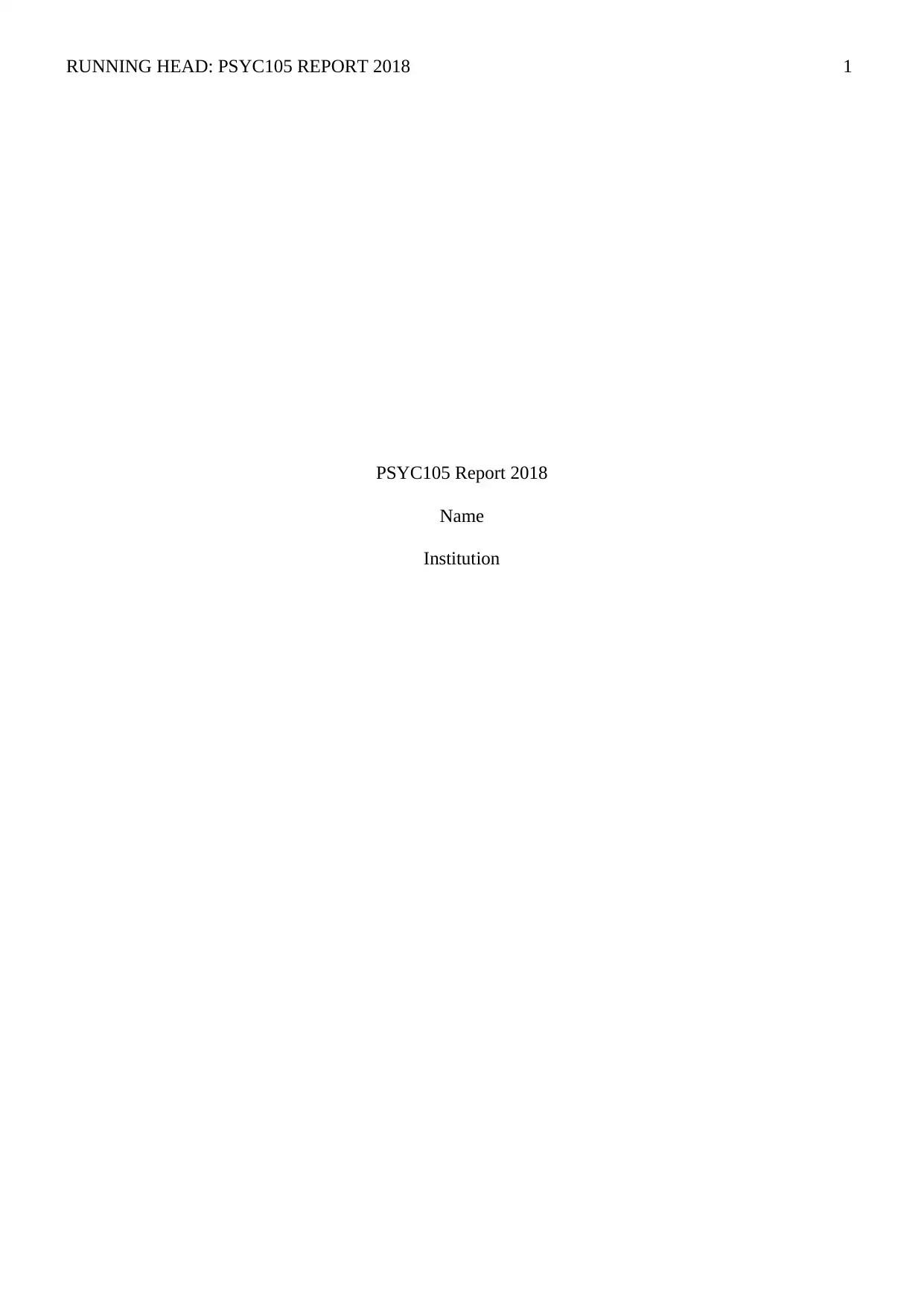
RUNNING HEAD: PSYC105 REPORT 2018 1
PSYC105 Report 2018
Name
Institution
PSYC105 Report 2018
Name
Institution
Paraphrase This Document
Need a fresh take? Get an instant paraphrase of this document with our AI Paraphraser
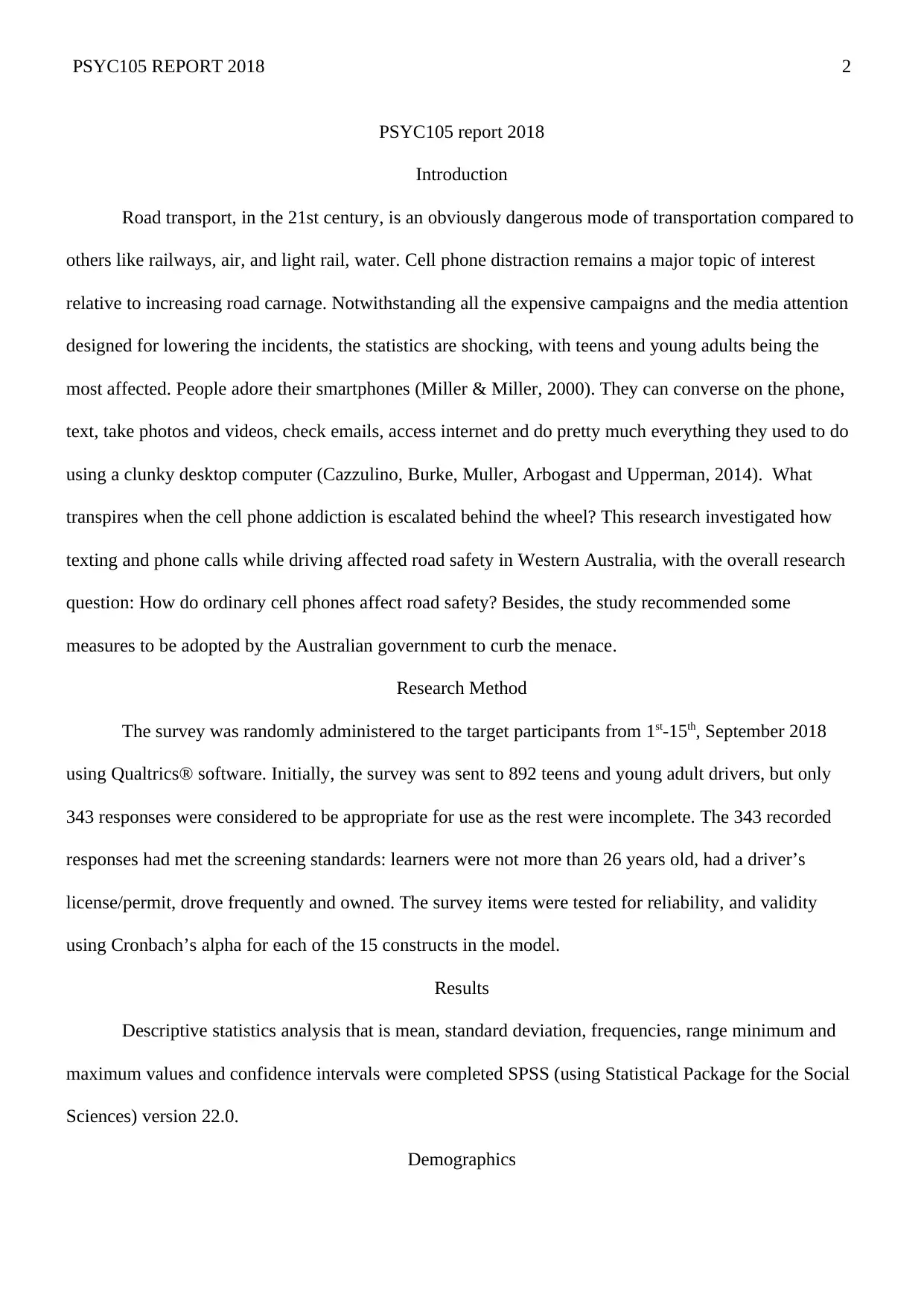
PSYC105 REPORT 2018 2
PSYC105 report 2018
Introduction
Road transport, in the 21st century, is an obviously dangerous mode of transportation compared to
others like railways, air, and light rail, water. Cell phone distraction remains a major topic of interest
relative to increasing road carnage. Notwithstanding all the expensive campaigns and the media attention
designed for lowering the incidents, the statistics are shocking, with teens and young adults being the
most affected. People adore their smartphones (Miller & Miller, 2000). They can converse on the phone,
text, take photos and videos, check emails, access internet and do pretty much everything they used to do
using a clunky desktop computer (Cazzulino, Burke, Muller, Arbogast and Upperman, 2014). What
transpires when the cell phone addiction is escalated behind the wheel? This research investigated how
texting and phone calls while driving affected road safety in Western Australia, with the overall research
question: How do ordinary cell phones affect road safety? Besides, the study recommended some
measures to be adopted by the Australian government to curb the menace.
Research Method
The survey was randomly administered to the target participants from 1st-15th, September 2018
using Qualtrics® software. Initially, the survey was sent to 892 teens and young adult drivers, but only
343 responses were considered to be appropriate for use as the rest were incomplete. The 343 recorded
responses had met the screening standards: learners were not more than 26 years old, had a driver’s
license/permit, drove frequently and owned. The survey items were tested for reliability, and validity
using Cronbach’s alpha for each of the 15 constructs in the model.
Results
Descriptive statistics analysis that is mean, standard deviation, frequencies, range minimum and
maximum values and confidence intervals were completed SPSS (using Statistical Package for the Social
Sciences) version 22.0.
Demographics
PSYC105 report 2018
Introduction
Road transport, in the 21st century, is an obviously dangerous mode of transportation compared to
others like railways, air, and light rail, water. Cell phone distraction remains a major topic of interest
relative to increasing road carnage. Notwithstanding all the expensive campaigns and the media attention
designed for lowering the incidents, the statistics are shocking, with teens and young adults being the
most affected. People adore their smartphones (Miller & Miller, 2000). They can converse on the phone,
text, take photos and videos, check emails, access internet and do pretty much everything they used to do
using a clunky desktop computer (Cazzulino, Burke, Muller, Arbogast and Upperman, 2014). What
transpires when the cell phone addiction is escalated behind the wheel? This research investigated how
texting and phone calls while driving affected road safety in Western Australia, with the overall research
question: How do ordinary cell phones affect road safety? Besides, the study recommended some
measures to be adopted by the Australian government to curb the menace.
Research Method
The survey was randomly administered to the target participants from 1st-15th, September 2018
using Qualtrics® software. Initially, the survey was sent to 892 teens and young adult drivers, but only
343 responses were considered to be appropriate for use as the rest were incomplete. The 343 recorded
responses had met the screening standards: learners were not more than 26 years old, had a driver’s
license/permit, drove frequently and owned. The survey items were tested for reliability, and validity
using Cronbach’s alpha for each of the 15 constructs in the model.
Results
Descriptive statistics analysis that is mean, standard deviation, frequencies, range minimum and
maximum values and confidence intervals were completed SPSS (using Statistical Package for the Social
Sciences) version 22.0.
Demographics
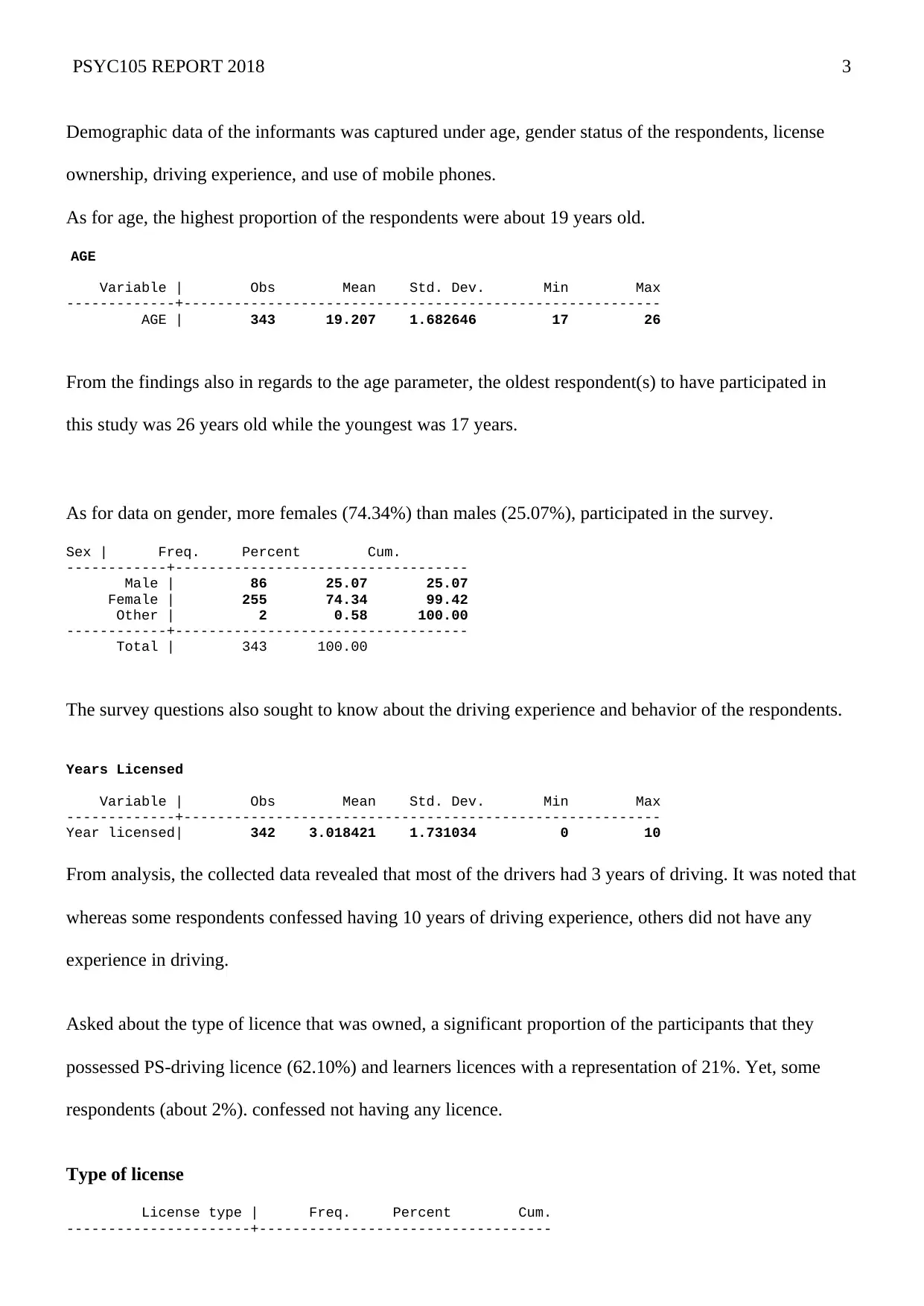
PSYC105 REPORT 2018 3
Demographic data of the informants was captured under age, gender status of the respondents, license
ownership, driving experience, and use of mobile phones.
As for age, the highest proportion of the respondents were about 19 years old.
AGE
Variable | Obs Mean Std. Dev. Min Max
-------------+---------------------------------------------------------
AGE | 343 19.207 1.682646 17 26
From the findings also in regards to the age parameter, the oldest respondent(s) to have participated in
this study was 26 years old while the youngest was 17 years.
As for data on gender, more females (74.34%) than males (25.07%), participated in the survey.
Sex | Freq. Percent Cum.
------------+-----------------------------------
Male | 86 25.07 25.07
Female | 255 74.34 99.42
Other | 2 0.58 100.00
------------+-----------------------------------
Total | 343 100.00
The survey questions also sought to know about the driving experience and behavior of the respondents.
Years Licensed
Variable | Obs Mean Std. Dev. Min Max
-------------+---------------------------------------------------------
Year licensed| 342 3.018421 1.731034 0 10
From analysis, the collected data revealed that most of the drivers had 3 years of driving. It was noted that
whereas some respondents confessed having 10 years of driving experience, others did not have any
experience in driving.
Asked about the type of licence that was owned, a significant proportion of the participants that they
possessed PS-driving licence (62.10%) and learners licences with a representation of 21%. Yet, some
respondents (about 2%). confessed not having any licence.
Type of license
License type | Freq. Percent Cum.
----------------------+-----------------------------------
Demographic data of the informants was captured under age, gender status of the respondents, license
ownership, driving experience, and use of mobile phones.
As for age, the highest proportion of the respondents were about 19 years old.
AGE
Variable | Obs Mean Std. Dev. Min Max
-------------+---------------------------------------------------------
AGE | 343 19.207 1.682646 17 26
From the findings also in regards to the age parameter, the oldest respondent(s) to have participated in
this study was 26 years old while the youngest was 17 years.
As for data on gender, more females (74.34%) than males (25.07%), participated in the survey.
Sex | Freq. Percent Cum.
------------+-----------------------------------
Male | 86 25.07 25.07
Female | 255 74.34 99.42
Other | 2 0.58 100.00
------------+-----------------------------------
Total | 343 100.00
The survey questions also sought to know about the driving experience and behavior of the respondents.
Years Licensed
Variable | Obs Mean Std. Dev. Min Max
-------------+---------------------------------------------------------
Year licensed| 342 3.018421 1.731034 0 10
From analysis, the collected data revealed that most of the drivers had 3 years of driving. It was noted that
whereas some respondents confessed having 10 years of driving experience, others did not have any
experience in driving.
Asked about the type of licence that was owned, a significant proportion of the participants that they
possessed PS-driving licence (62.10%) and learners licences with a representation of 21%. Yet, some
respondents (about 2%). confessed not having any licence.
Type of license
License type | Freq. Percent Cum.
----------------------+-----------------------------------
⊘ This is a preview!⊘
Do you want full access?
Subscribe today to unlock all pages.

Trusted by 1+ million students worldwide
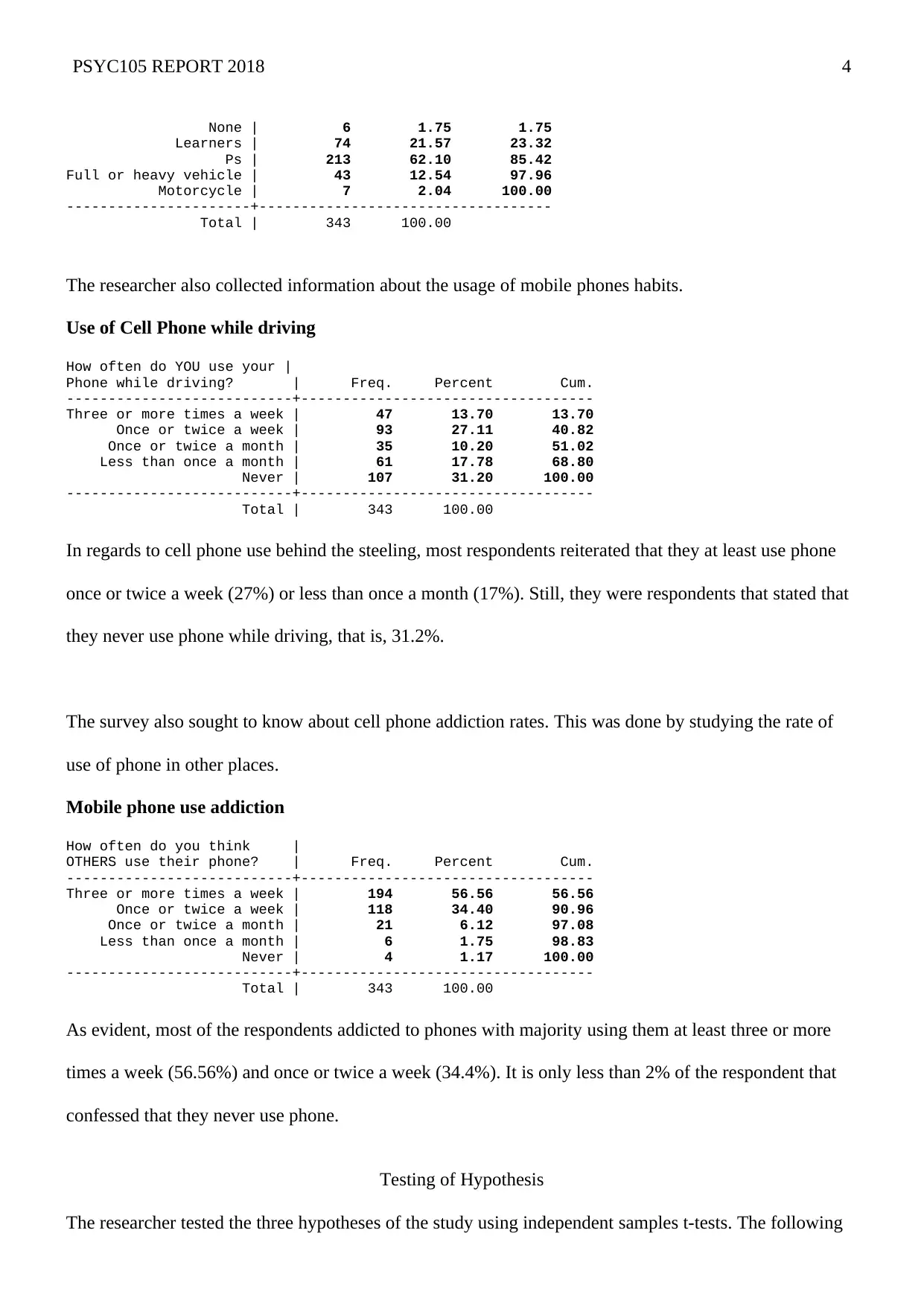
PSYC105 REPORT 2018 4
None | 6 1.75 1.75
Learners | 74 21.57 23.32
Ps | 213 62.10 85.42
Full or heavy vehicle | 43 12.54 97.96
Motorcycle | 7 2.04 100.00
----------------------+-----------------------------------
Total | 343 100.00
The researcher also collected information about the usage of mobile phones habits.
Use of Cell Phone while driving
How often do YOU use your |
Phone while driving? | Freq. Percent Cum.
---------------------------+-----------------------------------
Three or more times a week | 47 13.70 13.70
Once or twice a week | 93 27.11 40.82
Once or twice a month | 35 10.20 51.02
Less than once a month | 61 17.78 68.80
Never | 107 31.20 100.00
---------------------------+-----------------------------------
Total | 343 100.00
In regards to cell phone use behind the steeling, most respondents reiterated that they at least use phone
once or twice a week (27%) or less than once a month (17%). Still, they were respondents that stated that
they never use phone while driving, that is, 31.2%.
The survey also sought to know about cell phone addiction rates. This was done by studying the rate of
use of phone in other places.
Mobile phone use addiction
How often do you think |
OTHERS use their phone? | Freq. Percent Cum.
---------------------------+-----------------------------------
Three or more times a week | 194 56.56 56.56
Once or twice a week | 118 34.40 90.96
Once or twice a month | 21 6.12 97.08
Less than once a month | 6 1.75 98.83
Never | 4 1.17 100.00
---------------------------+-----------------------------------
Total | 343 100.00
As evident, most of the respondents addicted to phones with majority using them at least three or more
times a week (56.56%) and once or twice a week (34.4%). It is only less than 2% of the respondent that
confessed that they never use phone.
Testing of Hypothesis
The researcher tested the three hypotheses of the study using independent samples t-tests. The following
None | 6 1.75 1.75
Learners | 74 21.57 23.32
Ps | 213 62.10 85.42
Full or heavy vehicle | 43 12.54 97.96
Motorcycle | 7 2.04 100.00
----------------------+-----------------------------------
Total | 343 100.00
The researcher also collected information about the usage of mobile phones habits.
Use of Cell Phone while driving
How often do YOU use your |
Phone while driving? | Freq. Percent Cum.
---------------------------+-----------------------------------
Three or more times a week | 47 13.70 13.70
Once or twice a week | 93 27.11 40.82
Once or twice a month | 35 10.20 51.02
Less than once a month | 61 17.78 68.80
Never | 107 31.20 100.00
---------------------------+-----------------------------------
Total | 343 100.00
In regards to cell phone use behind the steeling, most respondents reiterated that they at least use phone
once or twice a week (27%) or less than once a month (17%). Still, they were respondents that stated that
they never use phone while driving, that is, 31.2%.
The survey also sought to know about cell phone addiction rates. This was done by studying the rate of
use of phone in other places.
Mobile phone use addiction
How often do you think |
OTHERS use their phone? | Freq. Percent Cum.
---------------------------+-----------------------------------
Three or more times a week | 194 56.56 56.56
Once or twice a week | 118 34.40 90.96
Once or twice a month | 21 6.12 97.08
Less than once a month | 6 1.75 98.83
Never | 4 1.17 100.00
---------------------------+-----------------------------------
Total | 343 100.00
As evident, most of the respondents addicted to phones with majority using them at least three or more
times a week (56.56%) and once or twice a week (34.4%). It is only less than 2% of the respondent that
confessed that they never use phone.
Testing of Hypothesis
The researcher tested the three hypotheses of the study using independent samples t-tests. The following
Paraphrase This Document
Need a fresh take? Get an instant paraphrase of this document with our AI Paraphraser

PSYC105 REPORT 2018 5
section details the results of the analysis.
Talking
• Hypothesis 1: Gain-framed, compared to loss-framed, safety messages about mobile phone use while
driving will be more effective in changing people’s intentions towards this behavior.
The results of the t-test in relation to this study are presented below.
Two-sample t test with equal variances
------------------------------------------------------------------------------
Variable | Obs Mean Std. Err. Std. Dev. [95% Conf. Interval]
---------+--------------------------------------------------------------------
Loss | 169 6.843195 .9029805 11.73875 5.060544 8.625846
Gain | 174 5.675287 1.000895 13.20271 3.69975 7.650825
---------+--------------------------------------------------------------------
combined | 343 6.250729 .6748446 12.4983 4.92336 7.578097
---------+--------------------------------------------------------------------
diff | 1.167908 1.35033 -1.488117 3.823933
------------------------------------------------------------------------------
diff = mean(Loss) - mean(Gain) t = 0.8649
Ho: diff = 0 degrees of freedom = 341
Ha: diff < 0 Ha: diff != 0 Ha: diff > 0
Pr(T < t) = 0.8062 Pr(|T| > |t|) = 0.3877 Pr(T > t) = 0.1938
Since the obtained Pr(|T| > |t|) = 0.3877< p-value 0.05 , the null hypothesis was rejected, that is, gain-
framed, compared to loss-framed, safety messages about mobile phone use while driving will not be more
effective in changing people’s intentions towards this behaviour.
• Hypothesis 2: High issue involvement inducing, compared to low issue involvement inducing, safety
messages will be more effective in changing people’s intentions about unsafe driving behaviour
Two-sample t test with equal variances
------------------------------------------------------------------------------
Variable | Obs Mean Std. Err. Std. Dev. [95% Conf. Interval]
---------+--------------------------------------------------------------------
Low | 182 4.431319 .845987 11.41299 2.762053 6.100584
High | 161 8.307453 1.053002 13.3611 6.227878 10.38703
---------+--------------------------------------------------------------------
combined | 343 6.250729 .6748446 12.4983 4.92336 7.578097
---------+--------------------------------------------------------------------
diff | -3.876135 1.337841 -6.507594 -1.244676
------------------------------------------------------------------------------
diff = mean(Low) - mean(High) t = -2.8973
Ho: diff = 0 degrees of freedom = 341
Ha: diff < 0 Ha: diff != 0 Ha: diff > 0
Pr(T < t) = 0.0020 Pr(|T| > |t|) = 0.0040 Pr(T > t) = 0.9980
section details the results of the analysis.
Talking
• Hypothesis 1: Gain-framed, compared to loss-framed, safety messages about mobile phone use while
driving will be more effective in changing people’s intentions towards this behavior.
The results of the t-test in relation to this study are presented below.
Two-sample t test with equal variances
------------------------------------------------------------------------------
Variable | Obs Mean Std. Err. Std. Dev. [95% Conf. Interval]
---------+--------------------------------------------------------------------
Loss | 169 6.843195 .9029805 11.73875 5.060544 8.625846
Gain | 174 5.675287 1.000895 13.20271 3.69975 7.650825
---------+--------------------------------------------------------------------
combined | 343 6.250729 .6748446 12.4983 4.92336 7.578097
---------+--------------------------------------------------------------------
diff | 1.167908 1.35033 -1.488117 3.823933
------------------------------------------------------------------------------
diff = mean(Loss) - mean(Gain) t = 0.8649
Ho: diff = 0 degrees of freedom = 341
Ha: diff < 0 Ha: diff != 0 Ha: diff > 0
Pr(T < t) = 0.8062 Pr(|T| > |t|) = 0.3877 Pr(T > t) = 0.1938
Since the obtained Pr(|T| > |t|) = 0.3877< p-value 0.05 , the null hypothesis was rejected, that is, gain-
framed, compared to loss-framed, safety messages about mobile phone use while driving will not be more
effective in changing people’s intentions towards this behaviour.
• Hypothesis 2: High issue involvement inducing, compared to low issue involvement inducing, safety
messages will be more effective in changing people’s intentions about unsafe driving behaviour
Two-sample t test with equal variances
------------------------------------------------------------------------------
Variable | Obs Mean Std. Err. Std. Dev. [95% Conf. Interval]
---------+--------------------------------------------------------------------
Low | 182 4.431319 .845987 11.41299 2.762053 6.100584
High | 161 8.307453 1.053002 13.3611 6.227878 10.38703
---------+--------------------------------------------------------------------
combined | 343 6.250729 .6748446 12.4983 4.92336 7.578097
---------+--------------------------------------------------------------------
diff | -3.876135 1.337841 -6.507594 -1.244676
------------------------------------------------------------------------------
diff = mean(Low) - mean(High) t = -2.8973
Ho: diff = 0 degrees of freedom = 341
Ha: diff < 0 Ha: diff != 0 Ha: diff > 0
Pr(T < t) = 0.0020 Pr(|T| > |t|) = 0.0040 Pr(T > t) = 0.9980
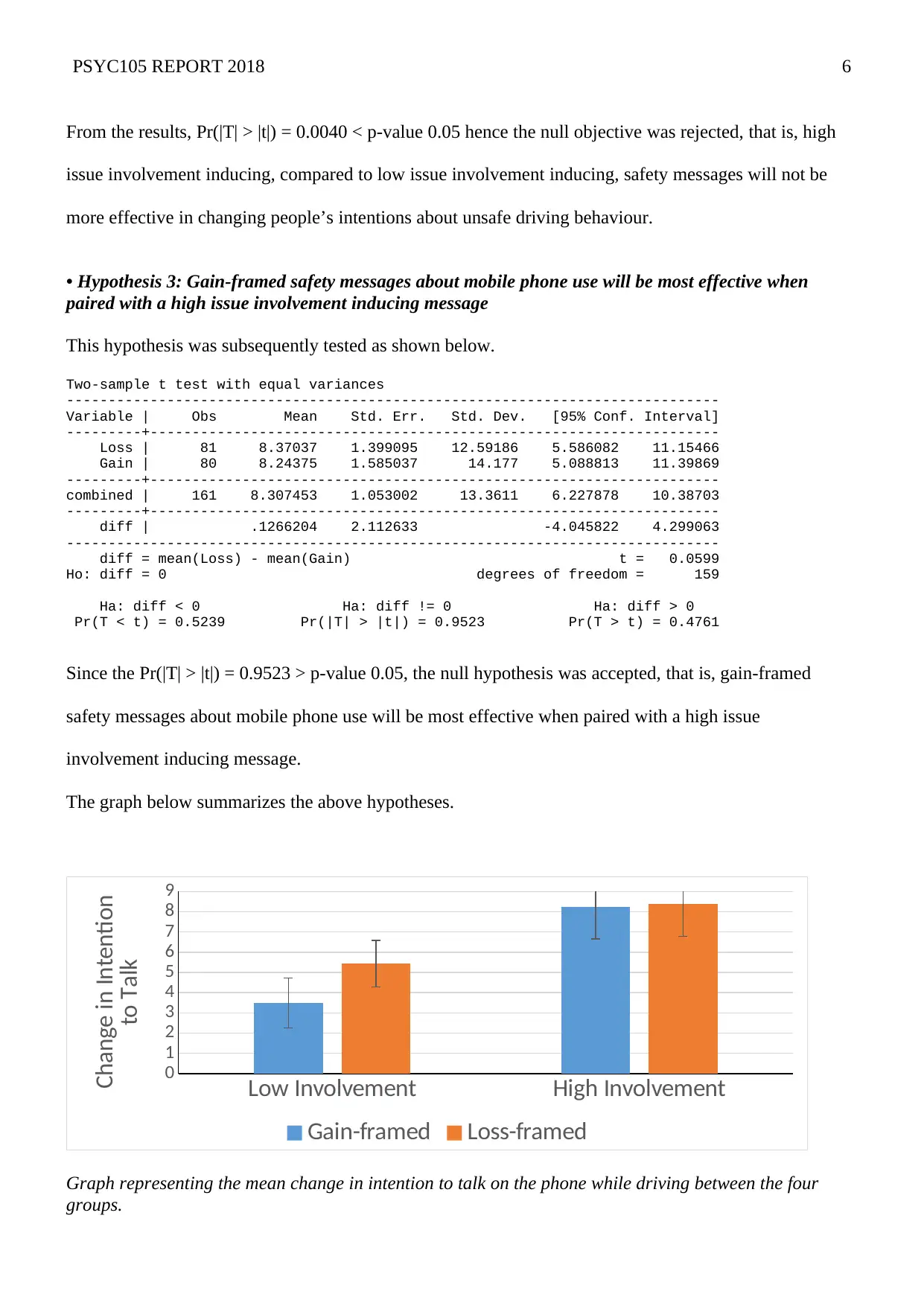
PSYC105 REPORT 2018 6
From the results, Pr(|T| > |t|) = 0.0040 < p-value 0.05 hence the null objective was rejected, that is, high
issue involvement inducing, compared to low issue involvement inducing, safety messages will not be
more effective in changing people’s intentions about unsafe driving behaviour.
• Hypothesis 3: Gain-framed safety messages about mobile phone use will be most effective when
paired with a high issue involvement inducing message
This hypothesis was subsequently tested as shown below.
Two-sample t test with equal variances
------------------------------------------------------------------------------
Variable | Obs Mean Std. Err. Std. Dev. [95% Conf. Interval]
---------+--------------------------------------------------------------------
Loss | 81 8.37037 1.399095 12.59186 5.586082 11.15466
Gain | 80 8.24375 1.585037 14.177 5.088813 11.39869
---------+--------------------------------------------------------------------
combined | 161 8.307453 1.053002 13.3611 6.227878 10.38703
---------+--------------------------------------------------------------------
diff | .1266204 2.112633 -4.045822 4.299063
------------------------------------------------------------------------------
diff = mean(Loss) - mean(Gain) t = 0.0599
Ho: diff = 0 degrees of freedom = 159
Ha: diff < 0 Ha: diff != 0 Ha: diff > 0
Pr(T < t) = 0.5239 Pr(|T| > |t|) = 0.9523 Pr(T > t) = 0.4761
Since the Pr(|T| > |t|) = 0.9523 > p-value 0.05, the null hypothesis was accepted, that is, gain-framed
safety messages about mobile phone use will be most effective when paired with a high issue
involvement inducing message.
The graph below summarizes the above hypotheses.
Low Involvement High Involvement
0
1
2
3
4
5
6
7
8
9
Gain-framed Loss-framed
Change in Intention
to Talk
Graph representing the mean change in intention to talk on the phone while driving between the four
groups.
From the results, Pr(|T| > |t|) = 0.0040 < p-value 0.05 hence the null objective was rejected, that is, high
issue involvement inducing, compared to low issue involvement inducing, safety messages will not be
more effective in changing people’s intentions about unsafe driving behaviour.
• Hypothesis 3: Gain-framed safety messages about mobile phone use will be most effective when
paired with a high issue involvement inducing message
This hypothesis was subsequently tested as shown below.
Two-sample t test with equal variances
------------------------------------------------------------------------------
Variable | Obs Mean Std. Err. Std. Dev. [95% Conf. Interval]
---------+--------------------------------------------------------------------
Loss | 81 8.37037 1.399095 12.59186 5.586082 11.15466
Gain | 80 8.24375 1.585037 14.177 5.088813 11.39869
---------+--------------------------------------------------------------------
combined | 161 8.307453 1.053002 13.3611 6.227878 10.38703
---------+--------------------------------------------------------------------
diff | .1266204 2.112633 -4.045822 4.299063
------------------------------------------------------------------------------
diff = mean(Loss) - mean(Gain) t = 0.0599
Ho: diff = 0 degrees of freedom = 159
Ha: diff < 0 Ha: diff != 0 Ha: diff > 0
Pr(T < t) = 0.5239 Pr(|T| > |t|) = 0.9523 Pr(T > t) = 0.4761
Since the Pr(|T| > |t|) = 0.9523 > p-value 0.05, the null hypothesis was accepted, that is, gain-framed
safety messages about mobile phone use will be most effective when paired with a high issue
involvement inducing message.
The graph below summarizes the above hypotheses.
Low Involvement High Involvement
0
1
2
3
4
5
6
7
8
9
Gain-framed Loss-framed
Change in Intention
to Talk
Graph representing the mean change in intention to talk on the phone while driving between the four
groups.
⊘ This is a preview!⊘
Do you want full access?
Subscribe today to unlock all pages.

Trusted by 1+ million students worldwide
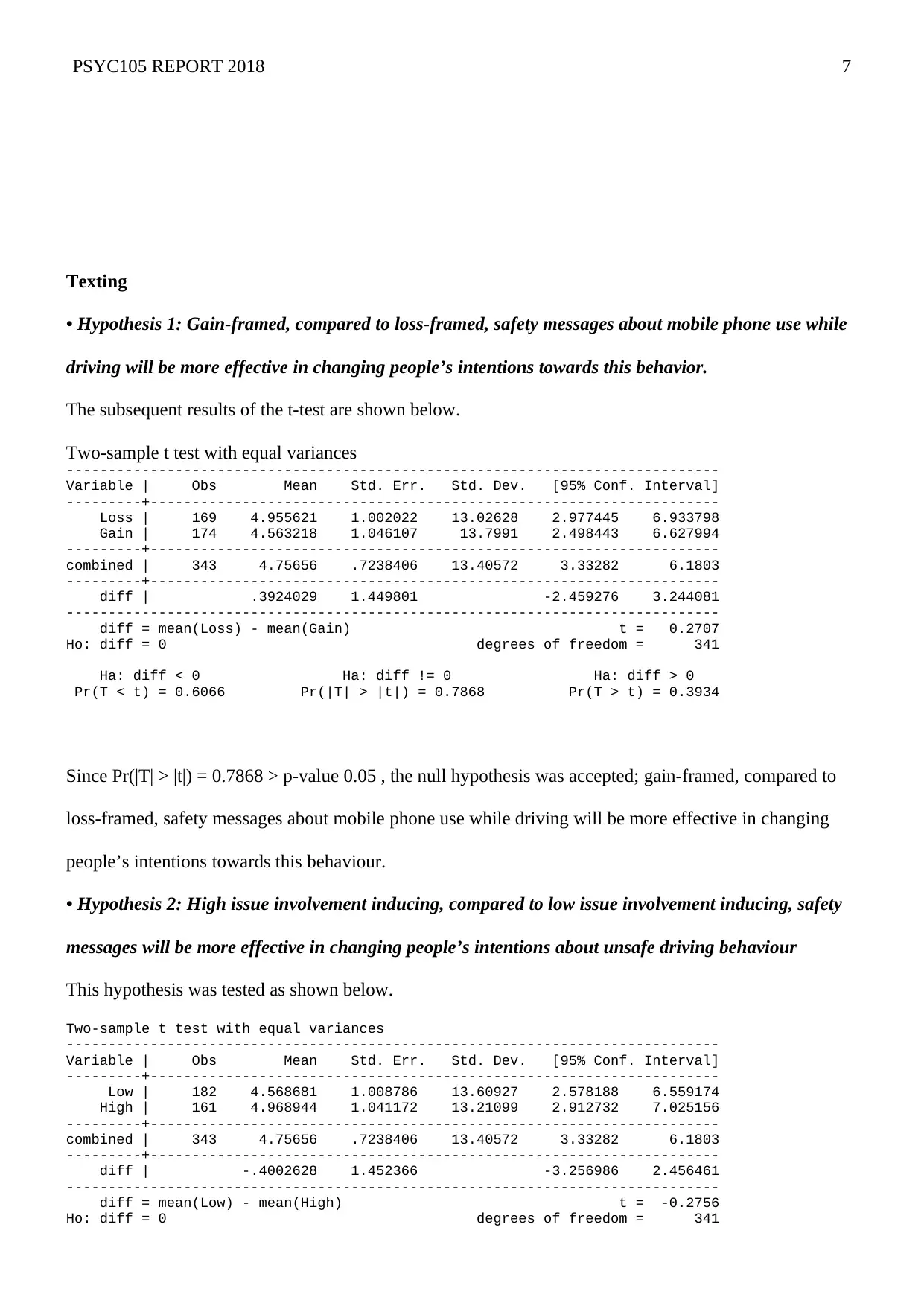
PSYC105 REPORT 2018 7
Texting
• Hypothesis 1: Gain-framed, compared to loss-framed, safety messages about mobile phone use while
driving will be more effective in changing people’s intentions towards this behavior.
The subsequent results of the t-test are shown below.
Two-sample t test with equal variances
------------------------------------------------------------------------------
Variable | Obs Mean Std. Err. Std. Dev. [95% Conf. Interval]
---------+--------------------------------------------------------------------
Loss | 169 4.955621 1.002022 13.02628 2.977445 6.933798
Gain | 174 4.563218 1.046107 13.7991 2.498443 6.627994
---------+--------------------------------------------------------------------
combined | 343 4.75656 .7238406 13.40572 3.33282 6.1803
---------+--------------------------------------------------------------------
diff | .3924029 1.449801 -2.459276 3.244081
------------------------------------------------------------------------------
diff = mean(Loss) - mean(Gain) t = 0.2707
Ho: diff = 0 degrees of freedom = 341
Ha: diff < 0 Ha: diff != 0 Ha: diff > 0
Pr(T < t) = 0.6066 Pr(|T| > |t|) = 0.7868 Pr(T > t) = 0.3934
Since Pr(|T| > |t|) = 0.7868 > p-value 0.05 , the null hypothesis was accepted; gain-framed, compared to
loss-framed, safety messages about mobile phone use while driving will be more effective in changing
people’s intentions towards this behaviour.
• Hypothesis 2: High issue involvement inducing, compared to low issue involvement inducing, safety
messages will be more effective in changing people’s intentions about unsafe driving behaviour
This hypothesis was tested as shown below.
Two-sample t test with equal variances
------------------------------------------------------------------------------
Variable | Obs Mean Std. Err. Std. Dev. [95% Conf. Interval]
---------+--------------------------------------------------------------------
Low | 182 4.568681 1.008786 13.60927 2.578188 6.559174
High | 161 4.968944 1.041172 13.21099 2.912732 7.025156
---------+--------------------------------------------------------------------
combined | 343 4.75656 .7238406 13.40572 3.33282 6.1803
---------+--------------------------------------------------------------------
diff | -.4002628 1.452366 -3.256986 2.456461
------------------------------------------------------------------------------
diff = mean(Low) - mean(High) t = -0.2756
Ho: diff = 0 degrees of freedom = 341
Texting
• Hypothesis 1: Gain-framed, compared to loss-framed, safety messages about mobile phone use while
driving will be more effective in changing people’s intentions towards this behavior.
The subsequent results of the t-test are shown below.
Two-sample t test with equal variances
------------------------------------------------------------------------------
Variable | Obs Mean Std. Err. Std. Dev. [95% Conf. Interval]
---------+--------------------------------------------------------------------
Loss | 169 4.955621 1.002022 13.02628 2.977445 6.933798
Gain | 174 4.563218 1.046107 13.7991 2.498443 6.627994
---------+--------------------------------------------------------------------
combined | 343 4.75656 .7238406 13.40572 3.33282 6.1803
---------+--------------------------------------------------------------------
diff | .3924029 1.449801 -2.459276 3.244081
------------------------------------------------------------------------------
diff = mean(Loss) - mean(Gain) t = 0.2707
Ho: diff = 0 degrees of freedom = 341
Ha: diff < 0 Ha: diff != 0 Ha: diff > 0
Pr(T < t) = 0.6066 Pr(|T| > |t|) = 0.7868 Pr(T > t) = 0.3934
Since Pr(|T| > |t|) = 0.7868 > p-value 0.05 , the null hypothesis was accepted; gain-framed, compared to
loss-framed, safety messages about mobile phone use while driving will be more effective in changing
people’s intentions towards this behaviour.
• Hypothesis 2: High issue involvement inducing, compared to low issue involvement inducing, safety
messages will be more effective in changing people’s intentions about unsafe driving behaviour
This hypothesis was tested as shown below.
Two-sample t test with equal variances
------------------------------------------------------------------------------
Variable | Obs Mean Std. Err. Std. Dev. [95% Conf. Interval]
---------+--------------------------------------------------------------------
Low | 182 4.568681 1.008786 13.60927 2.578188 6.559174
High | 161 4.968944 1.041172 13.21099 2.912732 7.025156
---------+--------------------------------------------------------------------
combined | 343 4.75656 .7238406 13.40572 3.33282 6.1803
---------+--------------------------------------------------------------------
diff | -.4002628 1.452366 -3.256986 2.456461
------------------------------------------------------------------------------
diff = mean(Low) - mean(High) t = -0.2756
Ho: diff = 0 degrees of freedom = 341
Paraphrase This Document
Need a fresh take? Get an instant paraphrase of this document with our AI Paraphraser
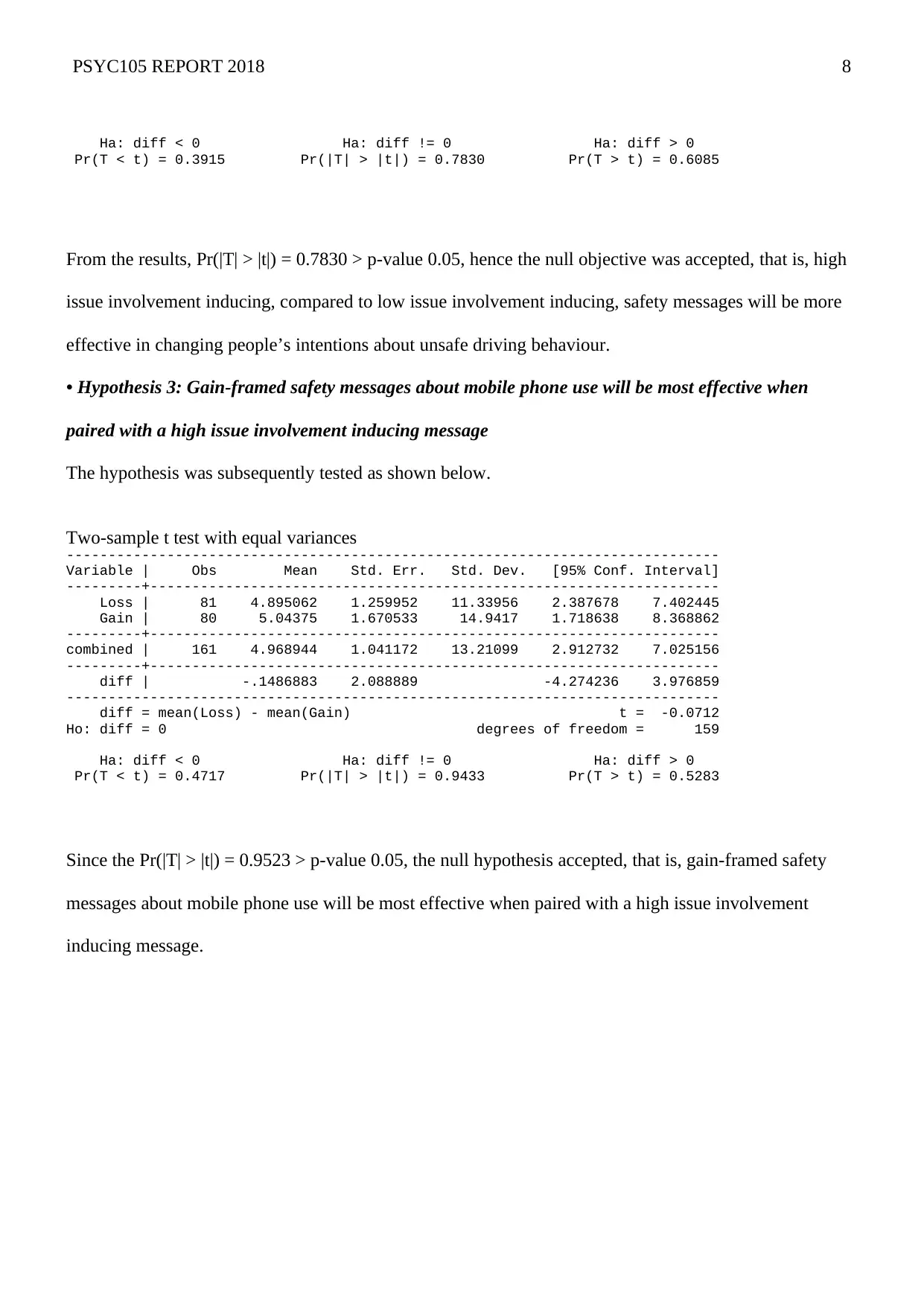
PSYC105 REPORT 2018 8
Ha: diff < 0 Ha: diff != 0 Ha: diff > 0
Pr(T < t) = 0.3915 Pr(|T| > |t|) = 0.7830 Pr(T > t) = 0.6085
From the results, Pr(|T| > |t|) = 0.7830 > p-value 0.05, hence the null objective was accepted, that is, high
issue involvement inducing, compared to low issue involvement inducing, safety messages will be more
effective in changing people’s intentions about unsafe driving behaviour.
• Hypothesis 3: Gain-framed safety messages about mobile phone use will be most effective when
paired with a high issue involvement inducing message
The hypothesis was subsequently tested as shown below.
Two-sample t test with equal variances
------------------------------------------------------------------------------
Variable | Obs Mean Std. Err. Std. Dev. [95% Conf. Interval]
---------+--------------------------------------------------------------------
Loss | 81 4.895062 1.259952 11.33956 2.387678 7.402445
Gain | 80 5.04375 1.670533 14.9417 1.718638 8.368862
---------+--------------------------------------------------------------------
combined | 161 4.968944 1.041172 13.21099 2.912732 7.025156
---------+--------------------------------------------------------------------
diff | -.1486883 2.088889 -4.274236 3.976859
------------------------------------------------------------------------------
diff = mean(Loss) - mean(Gain) t = -0.0712
Ho: diff = 0 degrees of freedom = 159
Ha: diff < 0 Ha: diff != 0 Ha: diff > 0
Pr(T < t) = 0.4717 Pr(|T| > |t|) = 0.9433 Pr(T > t) = 0.5283
Since the Pr(|T| > |t|) = 0.9523 > p-value 0.05, the null hypothesis accepted, that is, gain-framed safety
messages about mobile phone use will be most effective when paired with a high issue involvement
inducing message.
Ha: diff < 0 Ha: diff != 0 Ha: diff > 0
Pr(T < t) = 0.3915 Pr(|T| > |t|) = 0.7830 Pr(T > t) = 0.6085
From the results, Pr(|T| > |t|) = 0.7830 > p-value 0.05, hence the null objective was accepted, that is, high
issue involvement inducing, compared to low issue involvement inducing, safety messages will be more
effective in changing people’s intentions about unsafe driving behaviour.
• Hypothesis 3: Gain-framed safety messages about mobile phone use will be most effective when
paired with a high issue involvement inducing message
The hypothesis was subsequently tested as shown below.
Two-sample t test with equal variances
------------------------------------------------------------------------------
Variable | Obs Mean Std. Err. Std. Dev. [95% Conf. Interval]
---------+--------------------------------------------------------------------
Loss | 81 4.895062 1.259952 11.33956 2.387678 7.402445
Gain | 80 5.04375 1.670533 14.9417 1.718638 8.368862
---------+--------------------------------------------------------------------
combined | 161 4.968944 1.041172 13.21099 2.912732 7.025156
---------+--------------------------------------------------------------------
diff | -.1486883 2.088889 -4.274236 3.976859
------------------------------------------------------------------------------
diff = mean(Loss) - mean(Gain) t = -0.0712
Ho: diff = 0 degrees of freedom = 159
Ha: diff < 0 Ha: diff != 0 Ha: diff > 0
Pr(T < t) = 0.4717 Pr(|T| > |t|) = 0.9433 Pr(T > t) = 0.5283
Since the Pr(|T| > |t|) = 0.9523 > p-value 0.05, the null hypothesis accepted, that is, gain-framed safety
messages about mobile phone use will be most effective when paired with a high issue involvement
inducing message.
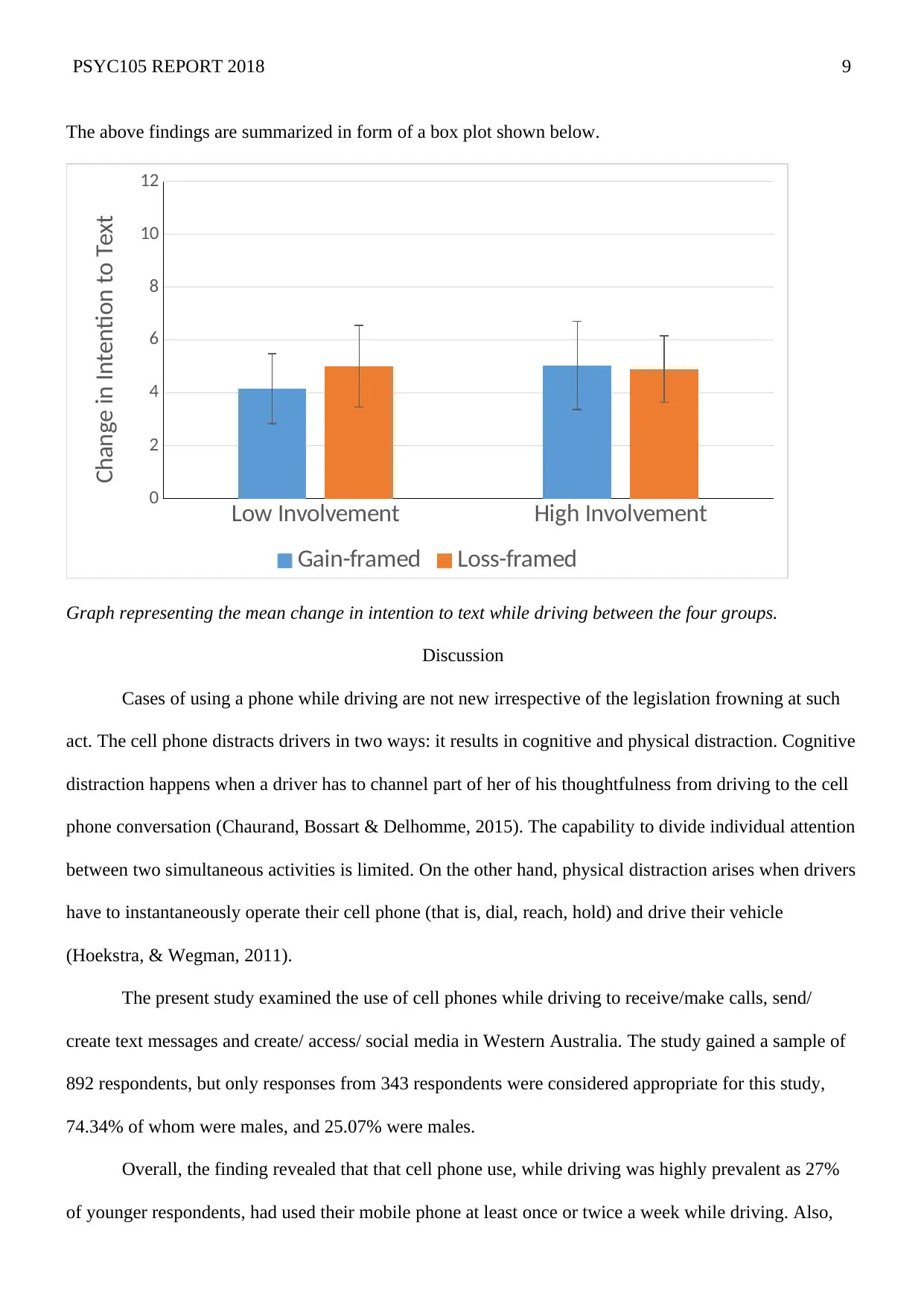
PSYC105 REPORT 2018 9
The above findings are summarized in form of a box plot shown below.
Low Involvement High Involvement
0
2
4
6
8
10
12
Gain-framed Loss-framed
Change in Intention to Text
Graph representing the mean change in intention to text while driving between the four groups.
Discussion
Cases of using a phone while driving are not new irrespective of the legislation frowning at such
act. The cell phone distracts drivers in two ways: it results in cognitive and physical distraction. Cognitive
distraction happens when a driver has to channel part of her of his thoughtfulness from driving to the cell
phone conversation (Chaurand, Bossart & Delhomme, 2015). The capability to divide individual attention
between two simultaneous activities is limited. On the other hand, physical distraction arises when drivers
have to instantaneously operate their cell phone (that is, dial, reach, hold) and drive their vehicle
(Hoekstra, & Wegman, 2011).
The present study examined the use of cell phones while driving to receive/make calls, send/
create text messages and create/ access/ social media in Western Australia. The study gained a sample of
892 respondents, but only responses from 343 respondents were considered appropriate for this study,
74.34% of whom were males, and 25.07% were males.
Overall, the finding revealed that that cell phone use, while driving was highly prevalent as 27%
of younger respondents, had used their mobile phone at least once or twice a week while driving. Also,
The above findings are summarized in form of a box plot shown below.
Low Involvement High Involvement
0
2
4
6
8
10
12
Gain-framed Loss-framed
Change in Intention to Text
Graph representing the mean change in intention to text while driving between the four groups.
Discussion
Cases of using a phone while driving are not new irrespective of the legislation frowning at such
act. The cell phone distracts drivers in two ways: it results in cognitive and physical distraction. Cognitive
distraction happens when a driver has to channel part of her of his thoughtfulness from driving to the cell
phone conversation (Chaurand, Bossart & Delhomme, 2015). The capability to divide individual attention
between two simultaneous activities is limited. On the other hand, physical distraction arises when drivers
have to instantaneously operate their cell phone (that is, dial, reach, hold) and drive their vehicle
(Hoekstra, & Wegman, 2011).
The present study examined the use of cell phones while driving to receive/make calls, send/
create text messages and create/ access/ social media in Western Australia. The study gained a sample of
892 respondents, but only responses from 343 respondents were considered appropriate for this study,
74.34% of whom were males, and 25.07% were males.
Overall, the finding revealed that that cell phone use, while driving was highly prevalent as 27%
of younger respondents, had used their mobile phone at least once or twice a week while driving. Also,
⊘ This is a preview!⊘
Do you want full access?
Subscribe today to unlock all pages.

Trusted by 1+ million students worldwide
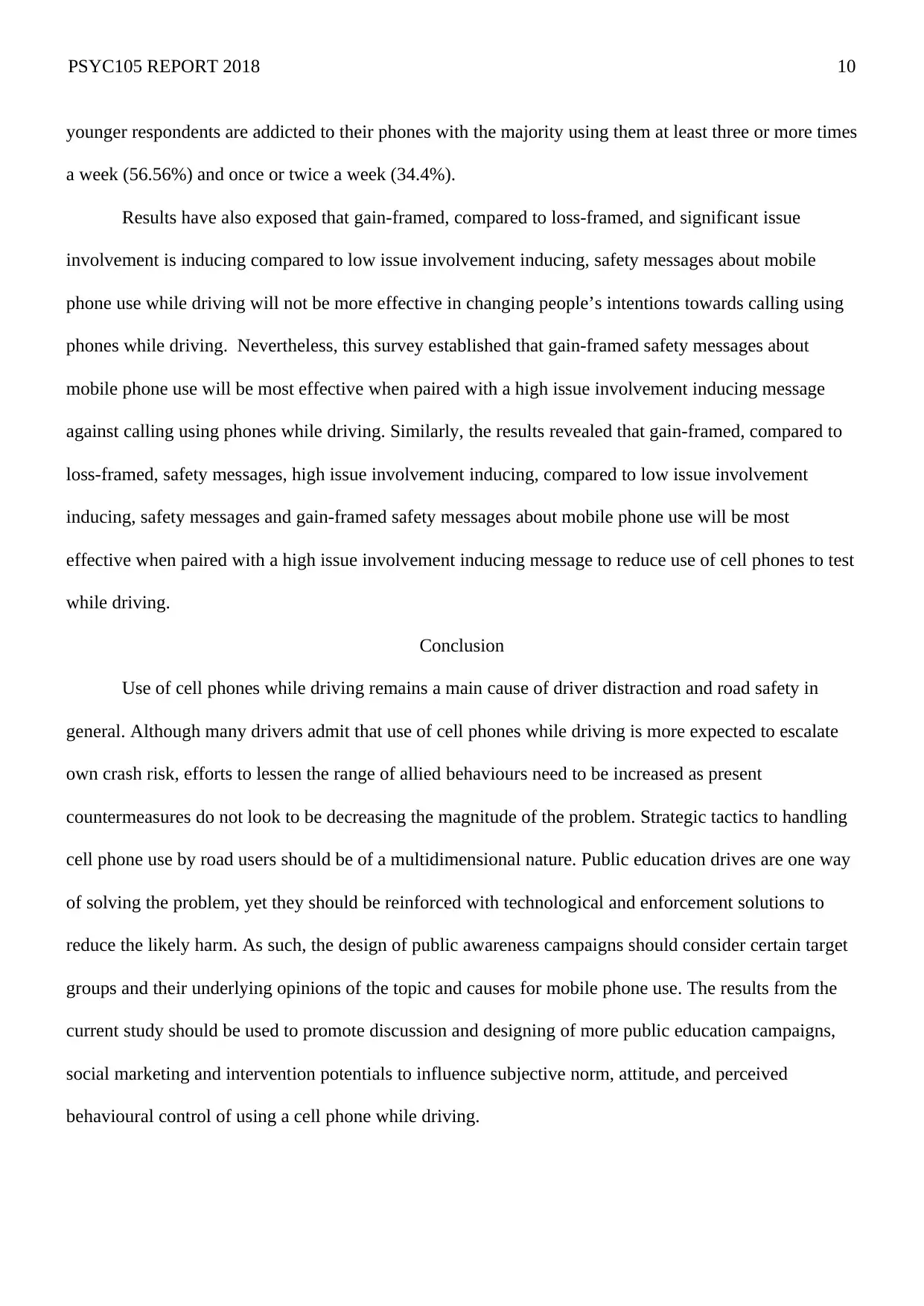
PSYC105 REPORT 2018 10
younger respondents are addicted to their phones with the majority using them at least three or more times
a week (56.56%) and once or twice a week (34.4%).
Results have also exposed that gain-framed, compared to loss-framed, and significant issue
involvement is inducing compared to low issue involvement inducing, safety messages about mobile
phone use while driving will not be more effective in changing people’s intentions towards calling using
phones while driving. Nevertheless, this survey established that gain-framed safety messages about
mobile phone use will be most effective when paired with a high issue involvement inducing message
against calling using phones while driving. Similarly, the results revealed that gain-framed, compared to
loss-framed, safety messages, high issue involvement inducing, compared to low issue involvement
inducing, safety messages and gain-framed safety messages about mobile phone use will be most
effective when paired with a high issue involvement inducing message to reduce use of cell phones to test
while driving.
Conclusion
Use of cell phones while driving remains a main cause of driver distraction and road safety in
general. Although many drivers admit that use of cell phones while driving is more expected to escalate
own crash risk, efforts to lessen the range of allied behaviours need to be increased as present
countermeasures do not look to be decreasing the magnitude of the problem. Strategic tactics to handling
cell phone use by road users should be of a multidimensional nature. Public education drives are one way
of solving the problem, yet they should be reinforced with technological and enforcement solutions to
reduce the likely harm. As such, the design of public awareness campaigns should consider certain target
groups and their underlying opinions of the topic and causes for mobile phone use. The results from the
current study should be used to promote discussion and designing of more public education campaigns,
social marketing and intervention potentials to influence subjective norm, attitude, and perceived
behavioural control of using a cell phone while driving.
younger respondents are addicted to their phones with the majority using them at least three or more times
a week (56.56%) and once or twice a week (34.4%).
Results have also exposed that gain-framed, compared to loss-framed, and significant issue
involvement is inducing compared to low issue involvement inducing, safety messages about mobile
phone use while driving will not be more effective in changing people’s intentions towards calling using
phones while driving. Nevertheless, this survey established that gain-framed safety messages about
mobile phone use will be most effective when paired with a high issue involvement inducing message
against calling using phones while driving. Similarly, the results revealed that gain-framed, compared to
loss-framed, safety messages, high issue involvement inducing, compared to low issue involvement
inducing, safety messages and gain-framed safety messages about mobile phone use will be most
effective when paired with a high issue involvement inducing message to reduce use of cell phones to test
while driving.
Conclusion
Use of cell phones while driving remains a main cause of driver distraction and road safety in
general. Although many drivers admit that use of cell phones while driving is more expected to escalate
own crash risk, efforts to lessen the range of allied behaviours need to be increased as present
countermeasures do not look to be decreasing the magnitude of the problem. Strategic tactics to handling
cell phone use by road users should be of a multidimensional nature. Public education drives are one way
of solving the problem, yet they should be reinforced with technological and enforcement solutions to
reduce the likely harm. As such, the design of public awareness campaigns should consider certain target
groups and their underlying opinions of the topic and causes for mobile phone use. The results from the
current study should be used to promote discussion and designing of more public education campaigns,
social marketing and intervention potentials to influence subjective norm, attitude, and perceived
behavioural control of using a cell phone while driving.
Paraphrase This Document
Need a fresh take? Get an instant paraphrase of this document with our AI Paraphraser
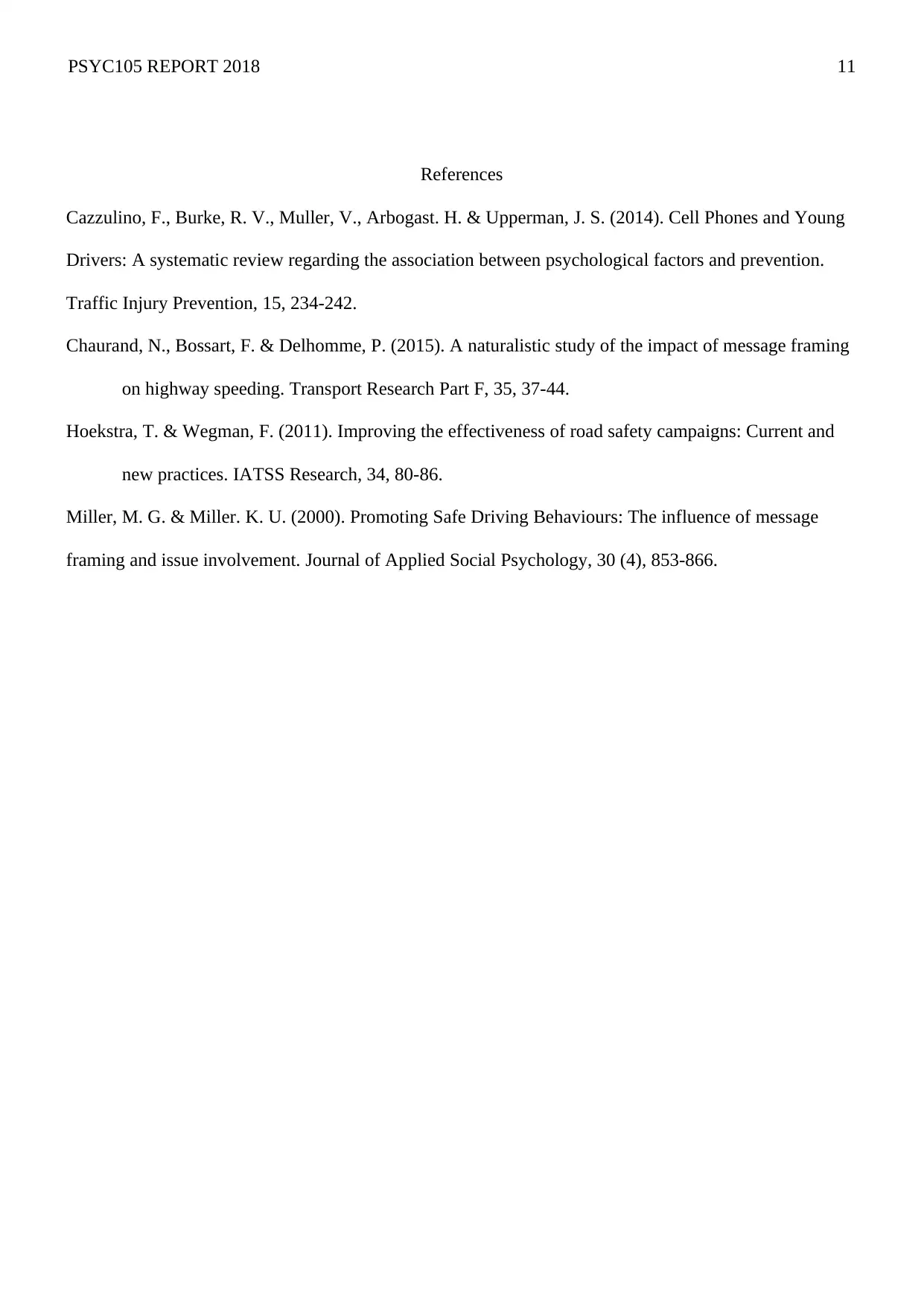
PSYC105 REPORT 2018 11
References
Cazzulino, F., Burke, R. V., Muller, V., Arbogast. H. & Upperman, J. S. (2014). Cell Phones and Young
Drivers: A systematic review regarding the association between psychological factors and prevention.
Traffic Injury Prevention, 15, 234-242.
Chaurand, N., Bossart, F. & Delhomme, P. (2015). A naturalistic study of the impact of message framing
on highway speeding. Transport Research Part F, 35, 37-44.
Hoekstra, T. & Wegman, F. (2011). Improving the effectiveness of road safety campaigns: Current and
new practices. IATSS Research, 34, 80-86.
Miller, M. G. & Miller. K. U. (2000). Promoting Safe Driving Behaviours: The influence of message
framing and issue involvement. Journal of Applied Social Psychology, 30 (4), 853-866.
References
Cazzulino, F., Burke, R. V., Muller, V., Arbogast. H. & Upperman, J. S. (2014). Cell Phones and Young
Drivers: A systematic review regarding the association between psychological factors and prevention.
Traffic Injury Prevention, 15, 234-242.
Chaurand, N., Bossart, F. & Delhomme, P. (2015). A naturalistic study of the impact of message framing
on highway speeding. Transport Research Part F, 35, 37-44.
Hoekstra, T. & Wegman, F. (2011). Improving the effectiveness of road safety campaigns: Current and
new practices. IATSS Research, 34, 80-86.
Miller, M. G. & Miller. K. U. (2000). Promoting Safe Driving Behaviours: The influence of message
framing and issue involvement. Journal of Applied Social Psychology, 30 (4), 853-866.
1 out of 11
Your All-in-One AI-Powered Toolkit for Academic Success.
+13062052269
info@desklib.com
Available 24*7 on WhatsApp / Email
![[object Object]](/_next/static/media/star-bottom.7253800d.svg)
Unlock your academic potential
Copyright © 2020–2025 A2Z Services. All Rights Reserved. Developed and managed by ZUCOL.